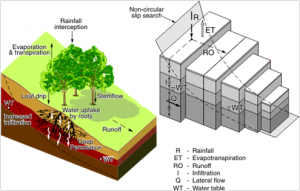Structure
CHASM is a physically based combined soil hydrology-slope stability model that allows simulation of changes in pore water pressures in response to individual rainfall events, and considers their role in maintaining slope stability.
The procedure adopted to model the slope hydrology is a forward explicit finite difference scheme, in which the slope is divided into a series of rectangular columns, each subdivided into regular cells. The model simulates detention storage, infiltration, evaporation, and unsaturated and saturated flow regimes. More specifically, rainfall is allowed to infiltrate the top cells governed by the infiltration capacity. Unsaturated vertical flow through each column is computed using the Richards’ equation (Richards, 1931), solved in explicit form, with the unsaturated conductivity defined by the Millington Quirk (1959) procedure. Flow between columns is modelled using the Darcy equation (Darcy, 1856) for saturated flow, adopting the Dupuit-Forscheimer (Forscheimer, 1930) assumption for the bottom boundary condition. Within the integrated model structure, the hydrology scheme also facilitates the representation of slope plan curvature (convexity and concavity), thereby allowing investigation into different topographic scenarios. This effect is represented by variable column breadth with downslope fluxes being enhanced due to slope plan convergence (reducing the downslope column breadth) or reduced due to slope plan divergence (increasing the downslope column breadth). The comprehensive integration of the unsaturated and saturated flow regimes allows determination of the pressure head field within the slope material, and subsequent input into the Bishop’s simplified circular method (Bishop, 1955) slope stability analysis.

